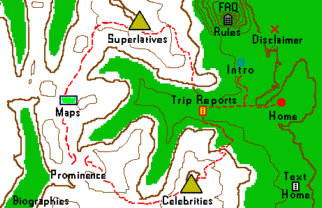
| Great Sand Dunes National Park Highpoint Information * |

|
This highpoint is a rocky outcrop about ten feet higher than the surrounding grassy slopes, with a large, mostly dead, gnarled bristlecone pine protruding from the top. A National Park Service sign proclaiming the park boundary is displayed prominently on a tree twenty feet due east of this spot. A small cairn with summit register can be found on the outcrop. National Park Service signs can be found along much of the park boundary.
Park highpoint The Great Sand Dunes Preserve boundary is farther north and west at Tijeras Peak (13,604+ feet) - Tijeras Peak The most-recognized sand dune is High Dune at 8,691 feet. It may also be the most prominent dune, with about 300 feet of prominence above its key saddle way to the north-north-east, and nearly seven hundred feet of gain above the usual tourist standing at Medano Creek. High Dune is fairly close to the Visitors Center - High Dune Dunes exceeding one hundred feet of prominence can be found along the northeastern edge of the dune field. They push up against the Sangre de Cristo Range, and exceed 8,800 feet elevation - highest dunes Small dunes about ten to twenty tall can be found as high as 9,500 feet, as they sneak their way up the valley formed by Little Medano Creek. Much of the lower slopes of the Sangres have sandy soil. The highest pure sand extent is shown here - highest pure sand